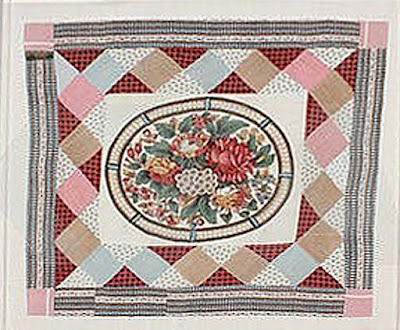Panel # 40 is another octagonal panel with a triple border
similar to a Georgian silver platter with a form of the "Leaf & Lozenge" border
as Kay Triplett mentioned in the last post's comments.
The central flower: an orange ranunculus with two red poppies in a supporting role.
An orange ranunculus is quite eye catching.
Similar floral imagery on an 18th-century plate from the
Sèvres Porcelain Manufactory in France. Collection of the Art Institute of Chicago
The pottery at Sèvres used a particular type of clay that took glazes well with vivid results. Very collectible pottery from this French factory, Europe's most fashionable porcelain source in the last half of the 18th century, gives us an idea of the long-lasting fashions for their classical, baroque and rococo imagery.
Porcelain table top from Sèvres
Sèvres created luxury items for the French aristocracy before and after the Revolution.
A printed cotton panel gave one a similar look for a more democratic price.
We have photos of only two quilts with panel #40, the first from Elizabeth Hake's 1937 book
English Quilting Old and New - With Notes on Its West Country Tradition: Five panels in the center area.
Four panels are in the corners of Elisabeth Capes's quilt in
KayTriplett's Collection
Capes's central, larger panel is #1, found often in the U.S. & the U.K.
Panel #40 is one of the rare panels with only two quilts in our database---both English. Perhaps if we did some research in English museums we'd find more. As collectors Lori and Kay Triplett write in their catalog of Chintz Quilts from the Poos Collection:
"The octagon pre-printed medallions are a bit more challenging to track down....It seems likely that the panels may have been printed as a series, or perhaps competing calico manufacturers copied successful designs."
We noted style characteristics in the last post---the work of one artist at one mill or several knockoffs?
See another octagonal pattern with jewel-like lozenges pinning the border:
Kay has written a comment here, reiterating the information on page 94 of her catalog.
"This quilt is inscribed 'This quilt was designed by Elizabeth Capes of CASTOR and finished by her Jan'y 1810, in the 63rd year of her age.' Also in cross stitch is SC 1809, which is probably her daughter Elizabeth Sabrah Capes....As far as I know, this is the oldest dated chintz panel quilt."
Castor is about 75 miles north of London, far from the West Country that Elizabeth Hakes explored in the 1930s.
What Can We Learn From This Panel?
The 1810 Elisabeth Capes quilt is the earliest date-inscribed panel quilt we have in our photo files. Dated quilts are rather rare but you can see a trend in the seven British quilts in our database. British quiltmakers appear to have made framed medallion quilts with panels between 1810 and 1835. All seven are attributed to England although they may not be there today.
Another way of looking at the dated sample.

We think this data is reliable enough to give us a range as to when to date a British frame quilt with
a panel---1810-1835. There is no evidence the style developed before 1800, although many captions in older books give that date.
Detail of the 1816 Princess Charlotte panel
The early-19th-century dates are corroborated with information on British textile history. Panels were printed on cotton, which was not abundant in 18th-century England, and they were printed with woodblocks, technology replaced by cylinder printing in the 1820s and '30s. Panels were an inexpensive decorating commodity, popular in the years before Queen Victoria's era.
Panels and porcelain
Porcelain-fronted desk
Read more about Sèvres decorative arts at the Metropolitan Museum Shop's site.
The only Sèvres I can afford to collect is their enameled tin reproductions.







































